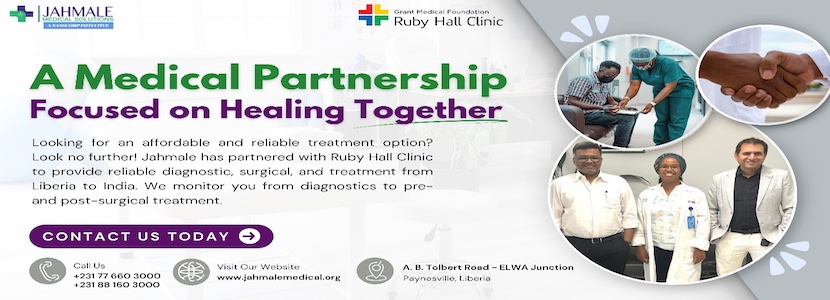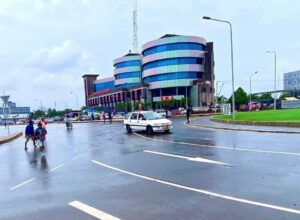
BY HUN-BU TULAY
EMAIL: ntevoma@gmail.com
Cell # +231886517356/777111032
The Silent Killers kill 7 persons per minute globally. This is 3.5 million people annually. The Silent Killers were the cause of the greatest mortality or the most fatal pandemic recorded in human history causing the death of one-third of the total population of Europe or approximately 75 million deaths in Western Eurasia and North Africa. It is referred to in history as the “Black Plague or Black Death.” It started in China in 1334 and spread to Europe and North Africa by trade routes. It entered Europe (London) in 1346 and within seven years (1353) these killers killed 75 million people. No war in human history killed as many people as the Black Death, even the war that lasted for 100 years.
Many of you reading this feature, might not have heard or read about the Black Plague or the cause of the Black Plague. It is an infectious fever caused by the Bacterium Yersinia pestis. Today scientists who have studied the Black Plague believed it was as a result of unsafe water supply (poor water supply), poor sanitation and poor hygiene practices. Common diseases associated with these conditions mentioned above are Cholera, Diarrhea, Dysentery, Hepatitis A, Typhoid, Polio, intestinal Worms, Trachoma, and Schistosomiasis. You will agree with us that each of these diseases is deadly.
Our country Liberia was in similar situation as Euroasia and North Africa in 1948 when there was an epidemic in Monrovia. The situation was so bad that the World Health Organization (WHO) threatened to close the country’s sea and air ports. In 1948, there were NO PIPEBORNE WATER SUPPLY AND SEWAGE COLLECTION NETWORKS. In 1950 president Tubman launched the country’s Five-Year Development Plan and water and sanitation was at the top of the plan with funds allocated and contributions from the USAID. In 1953 the pipe borne water supply and conventional collection sewage network were commissioned. As the city population was increasing so were the facilities providing water supply the service for example, from the first source of water supply which was an infiltration gallery constructed in Point Four, New Kru Town with a capacity of 2 million gallons per day in 1953. Seven years later, a 4 million gallon treated system (Slow Sand Filtration system) in 1960 in White Plains was established. Eight years later, the treatment capacity was increased to 16 million gallons in 1968 and the treatment system changed from Slow Sand Filtration System to Rapid Sand Filtration System.
The sewage collection network originally covered Central Monrovia and Mamba Point in 1953, which was collecting and discharging of the RAW SEWAGE into the Atlantic Ocean and nearby water bodies around Monrovia. The collection network was extended to Bushrod Island, Sinkor, and Congo Town up to Germany Embassy and a conventional treatment (High Rate Trickling Filter) was commissioned in 1970, stopping the discharge in the Ocean and rivers.
The government of Liberia working with partners, GTZ, USAID and European Union constructed and commissioned between the period 1971-1985, pipe-borne water supply in eight county capitals excluding Monrovia (Harper-Maryland, Greenville-Sinoe, Buchanan-Grand Bassa, Ropertsport-Grand-Cape Mount, Sanniquelle-Nimba, Gbarnga-Bong, Zwedru-Grand Gedeh, and Voinjama-Lofa). All of the systems were functioning before the Liberian Civil Crisis. During the period of the senseless Civil Crisis all the equipment were looted and infrastructures destroyed thereby interrupting pipe-borne water supply to these cities and reducing the water supply to Monrovia by 90%.
The Sirleaf-Boakai Administration taking their Constitutional responsibilities seriously, when it comes to protecting life and restoring dignity to its citizens, was quick to record that WATER IS LIFE AND SANITATION WAS DIGNITY. And in fulfillment of their constitutional responsibilities as per Article 20(a), which reads “ Nobody shall be deprived of LIFE”, which implies that depriving the citizens and all these residing in the territory borders if they are deprived of water would be equivalent to depriving them of Life, hence, violation of Article 20(a) of the constitution. That administration worked with the partners and restored pipe-borne water supply in seven county capitals (Monrovia, Buchanan, Zwedru, Kakata, Sanniquelle, Robertsport, and Voinjama). Working with the partners, they completed feasibility studies for restoring water supply for Gbarnga, Greenville, and Harper. Sirleaf was also working with the partners for water feasibility studies for six urban cities that had no pipe-borne water supply (Fish Town, Pleebo, Ganta, Bopolu, Tubmanburg, and Foya. The government also completed the feasibility study and design for rehabilitation of the Monrovia Sewer System and its expansion. The Fiama Plant was to be remolded replacing the High Rate Trickling Filter to Activated Sludge System, rehabilitation of the Monrovia Collection Network (pipes and lift stations) and the construction of two mini-systems (one in Paynesville and the other in Gardnersville at a cost of US$37,00 Million. The government was informed by the Task Manager for Liberia in November 2017 that the Washington Office has stowed US$20.00 Million for the Monrovia Sanitation Project. The Sirleaf and Baokai Administration turned over to the Weah Administration in 2018 100% rehabilitated Water Treatment Plant in White Plains with a treatment capacity of 16 million gallons or 60,000 cubic meters, six functioning outstations water systems, secured United States Dollars 20 million for the Monrovia Sewer rehabilitation, completed feasibility studies and design documents for rehabilitation of three outstation (Harper, Greenville, and Gbarnga) water supply systems, completed the Feasibility study and design of the Monrovia Transmission Pipelines and 75% negotiation for the replacement of the 36” and 16” Transmission Pipeline with 48” and 24” respectively supplying Monrovia with water, completion of two independent water systems for Monrovia (Soul Clinic and New Georgia Communities) and negotiated for feasibility studies for water supply for six cities (Bopolu, Fish Town, Ganta, Tubmanburg, Foya and Pleebo.
The Weah Administration has neglected its constitutional responsibility as stated in Article 20(a) by allowing all water facilities rehabilitated during the Sirleaf-Boakai Administration crumbled with the exception of Voinjama, Sanniquelle and Robertsport. These continue to function because they are operated by independent private contractors not LWSC. These contracts were signed long before the Weah Administration was inaugurated. This is the height of wickedness. The Weah Administration was trying to return the country to the 1948 situation. It has been two months, since the city of Monrovia last received Pipe-borne water supply. Our partners said that the city of Monrovia is the DIRTIEST in West Africa where Solid Waste can be found on every street, Sewage overflow is common in the city’s streets and now no water supply. The public health facilities are unable to cope with the pending health crisis associated with lack of safe water supply, poor sanitation and poor hygiene practices. Majority of Liberians (95%) cannot afford the cost of treatment at private health facilities or faith based facilities. Most of the diseases that are currently killing Liberians are preventable diseases (Cholera, Diarrhea, Dysentery, Hepatitis A, Typhoid, intestinal Worms, Trachoma, and Schitosomiasis). These diseases can be prevented by the supply of safe water, proper sanitation both solid waste and human wastes and good hygiene practices. According to the World Health Organization (WHO) and UN Water, investing in safe water supply and sanitation interventions results in many benefits which include economic, environmental, quality of life and health. Every United States Dollar invested in WASH Intervention gives a return of USD4.30 in the form of reduced health care cost, reduced pollution of water resources and the environment, and gains in quality of life, improved in school attendance, greater privacy, safety, and sense of dignity. The Weah Administration does not understand these. The question is why is the Weah Administration treating the Liberians who voted him this way? The government failed to know that if it does not intervene in WASH, the drivers, security personnel, filling clerks, the low level workers, the cooks, cleaners who live in communities that lack these facilities will be infected with one or two of these diseases and they will spread them to the rest of the staff or your children and you might get them from your children. Oh what a pity!
Twenty-one ago, a feature was written by the author entitled “THE SILENT BOMB”. Many of you reading this feature remember NPFL “Operations OCTOPUS”, which was launched on October 15, 1992. NPFL leader Charles Taylor launched the assault. Taylor intention was to overrun the ECOMOG Forces and taken over Monrovia and install himself as president. The surrounding communities of Monrovia were under sieged including the Water Treatment Plant in White Plains. Water supply to the city of over 1.0 million inhabitants was cutoff. When the feature was published, evil men, when to the interim President (Dr. Sawyer) and told him that the author was NPFL Supporter because they wanted his job. At the same time, ECOMOG of Chief, Victor Malu sent for the author. The question the ECOMOG Chief of Staff asked the author was “What can be done to save lives?” The author answered “Re capture the Water Treatment Plant in White Plains.” Caldwell Base of the INPFL was already captured by the NPFL Forces. The water plan was recaptured by ECOMOG‘s Senegalese Forces in White plains and Pipe-water was restored to the city. Today, we equally recommend that the donors work with both President Weah and President-elect Boakai to find solution to the city water, sanitation and solid waste problems in order to SAVE LIVES.
The officials of the Weah Administration continue to loot the country’s resources and work with some corrupt partners to deprive the Liberian people of some of the basic services mentioned above. We want to inform the donors to carefully monitor contracts that were signed in November and early December 2023. Some contractors and heads of agencies are working together to issue a Variation Order or Change orders for some projects. Let us remember that Variation Orders or Change Orders are issued for two main reasons: Events occur external to the contract, or their changes in the design, scope or circumstances. Other causes of Variation Orders impacting the project cost are additional works, client financial problems/delay in payment of bills and change in design. Can these be acted upon with the project team? Schemes are been planned to get money with NO JUSTIFICATIONS. In fact, Variation Orders are discussed between parties for many weeks or maybe months before they are approved. However these might be the cases in some of the current contract.
DONORS OPEN YOUR EYES.















